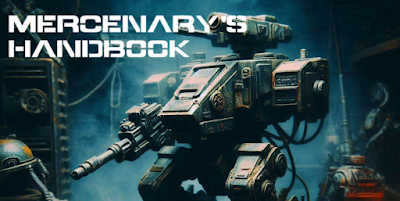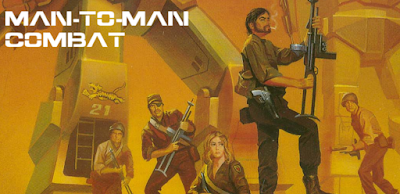Some games become foundational to who you are. MechWarrior is one of mine—it’s a core memory and the reason I met my best friend in primary school.
I owned the Red Box D&D set but had “played” it for maybe 30 minutes total at lunchtime. I devoured Fighting Fantasy books, loved Star Wars, The Dark Crystal, and the classic cartoons of Robotech and Star Blazers. Then, in grade 6, I changed schools. Everything was new, I had no friends, and I felt awkward.
One of the kids had a copy of MechWarrior - its spine breaking from wear, but he didn’t understand what it was. I did. I had the Red Box, I had read Fighting Fantasy, and I kind of knew what roleplaying was about. So we sat down, made characters, marveled at the color insert art and the cover, and dreamed of stompy robotech robots.
Almost 40 years later, we still haven’t played it.
That needs to change. I'm going to run Mechwarrior. I know only a little about the setting, never played any of the computer games and worst of all have never played Battletech. But I'm going to learn as much as I can and run this.
I'm starting with a read through of MechWarrior 1E—getting a feel for the setting, picking out what I like, and figuring out which rules work and which need more effort to understand before deciding whether to keep or change them. The setting stays as-is—only clunky rules get adjusted if I can’t make peace with them.
Prelude (2001-2100):
The Soviet Union collapses in 2011. By 2024, most nations, including former Soviet states, form an Alliance Parliament with a unified military. Trade booms, and by 2086, this evolves into the Terran Alliance with 120 nations. Fusion power fuels scientific progress, making long-distance space travel viable. We find habitable worlds, and private companies jump into space exploration, driving tech innovation.
Exodus (2102-2313):
By 2102, humanity develops FTL drives and begins settling the stars. Terra controls the colonies, but water shortages are a major issue, leading to ice ships trucking across space. The further out colonies are, the harder they are to govern. Many start self-ruling, and some declare independence. Lacking the political will to fight them, Terra undergoes a political crisis and shifts to isolationism, granting all colonies independence—whether they wanted it or not. Earth stagnates, and the smartest minds leave for the colonies.
Consolidation (2314-2398):
The Terran Alliance collapses into internal conflict. The Alliance fleet commander stages what reads like a coup, restoring control over 100 of 1500+ colonies. Now with colonial resources, Terra refocuses on tech, inventing WorkMechs using artificial muscle. Other colonies form their own alliances and fight over border worlds, water, and minerals. As hereditary rule stabilizes Terra, the colonies follow suit, seeing dynasties as a source of order.
The Age of War (2398-2550):
The major states go to war. The Ares Conventions establish rules of engagement to limit destruction—wars should be fought away from civilians and economic centers. War remains frequent but less devastating. Hereditary rule persists, except in the Rim Worlds, where a coup installs the Amaris family. I'm not sure how I feel about the major characters driving the through story - so far I think its interesting. Meanwhile, the Terran Hegemony, usually reluctant to fight, unveils BattleMechs—dominating the battlefield. The other states scramble to copy the tech, and soon, everyone has 'Mechs.
Imperium and Reunification (2551-2600):
After 150 years of war, Terra brokers peace, forming the Star League with the five Inner Sphere states. They share tech, while the Periphery, independent for 300 years, refuses to join. Star League crushes them in war, then spins it as a victory for peace, winning hearts and minds through PR.
The Good Years (2601-2750):
Under Star League, everything prospers. Hyper-Pulse Generators (HPGs) revolutionize interstellar communication—though a message from Terra to the Periphery still takes five months (faster options exist but are prohibitively expensive). Water purifiers eliminate scarcity. A universal currency (C-bill?) fuels a trade boom. Meanwhile, the Amaris family of the Rim Worlds starts scheming—building up troops, getting caught, and backing down.
Crisis and Civil War (2751-2784):
When eight-year-old Richard Cameron inherits the Star League throne, a regency council takes over—and mismanages everything. As Richard matures, he provokes the council, made up of Terra and the five Inner Sphere states. Meanwhile, unrest in the Periphery pulls away the Star League army.
The Amaris family offers Richard military support to defend Terra—but it’s a trap. Amaris seizes power in a bloody coup, wiping out Richard’s entire bloodline. Kerensky, head of the Star League military, declares war on Amaris. They fight across several star systems, and by the end, 100 million people are dead.
The Star League Council takes charge, kicks out Kerensky, then squabbles over the throne. The council never reconvenes—each of the five Inner Sphere rulers goes home to prepare for war. Kerensky, disillusioned, takes ¾ of the Star League army beyond the Periphery—never to be seen again. Quitter.
The 'Crisis and Civil War' era is the first viable timeline to run a mech game simply because mechs don't enter the timeline until then. I think the succession wars offer better support and is where I will end up setting the campaign. I am starting to understand the importance of all the names in the setting given the core hereditary themes running through everything.
The Succession Wars (2785–Present):
With Kerensky and the Star League army gone, civil war erupts.
The First Wave is brutal—most FTL shipbuilding capacity is destroyed, crippling trade. Water purifiers fail, but ice-ship tech keeps some colonies alive. Water worlds suddenly become valuable again.
The Second Wave is just as bad but even more devastating—it wipes out scientists and engineers. Tech is lost, regressing to 21st-century levels in most places. Equipment is cannibalized to keep the war machine going.
The Third Wave fizzles out—not because anyone wants peace, but because no one has the resources to keep going. The economy shifts to scavenging.
To prevent total collapse, new rules of war emerge—limiting destruction of key infrastructure. Surrendering and paying ransom become standard, and feudalism takes hold as central governments fail. Warlords rule planetary nobles, trading 'Mech service for loyalty.
On the Periphery, Bandit Kingdoms rise. The Inner Sphere balkanizes, and raids and piracy become a way of life.
***
It seems clear to me that the Succession Wars is the setting for me. But I'm not super interested in the inner sphere houses. I think the periphery has the most potential, particualry the bandit kingdoms. 1e Mechwarrior gives you more setting material later in the book but the 'History of Human Space' opening chapter is a great taste of what the setting is all about.
Next up character creation. I haven't made a mechwarrior character in nearly 40 years!














